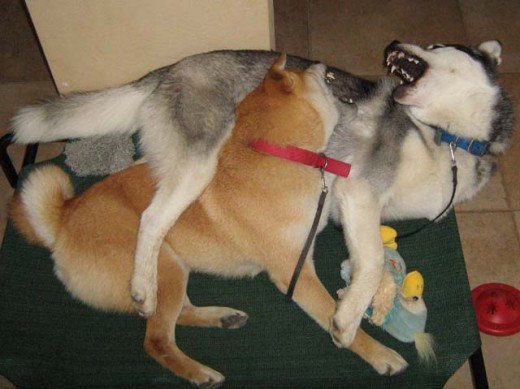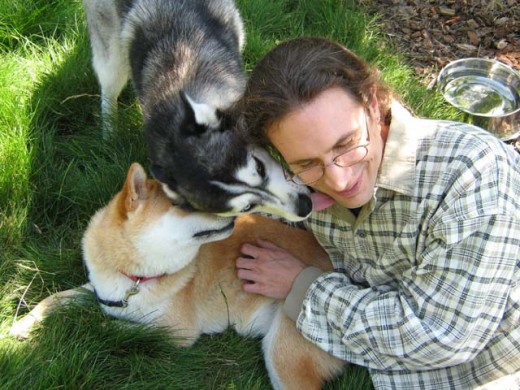It is especially difficult to become pack leader to an aggressive dog because we will naturally fear our dog’s aggression.
My Shiba Inu used to have the worst bouts of aggressive leash biting. He would jump up on me, grab my jacket sleeve, and shake his head very rigorously, in what I call the kill-move (the shaking, head tossing motion that animals make to kill prey).

The more fearful I got of my dog, the more aggressive he became. He started humping my leg, and attacked the leash whenever I held it. Thankfully, he never broke skin, because of bite inhibition training. Nevertheless, I dreaded walking my dog, or even just being with him.
Here are some techniques that helped me conquer my fear, and become pack leader to my aggressive dog.

1. Practice calm energy
Cesar Milan, The Dog Whisperer always emphasizes the importance of projecting calm energy, especially when interacting with an aggressive dog. If we interact with a dog using nervous, submissive, fearful, or otherwise unbalanced energy, the dog may pick up on that, get stressed himself, and behave badly or start showing aggression.
Some techniques that helped me remain calm include:
- Taking deep breaths and focusing on breathing to remain calm.
- Actively thinking of something else, whenever I start to get stressed about what my dog might do.
- Using the “tsch” from Cesar Millan. No, it is not a magical sound for calming dogs, but it helps to remind me to stay calm.
- Walking with an assertive posture (shoulders back, head up).
In addition, make sure that we are not putting undue tension on the leash.
The thing that helped me most was to imagine the worst that my dog could do. In the leash biting case, it was a bite to my hand or arm. I decided that for my Shiba Inu, I could deal with some bites. If he did that, I would hold firm, get him home as quickly as possible, and thus end the fun walk. If he continued to bite at me or the leash once we are home, I can put him directly in a time-out area. In this way, he learns that –
Biting on leash = End of walk or temporary loss of freedom,
No biting on leash = Fun walk and exploration continues.
Once I had a plan for dealing with the worst, I became less fearful.
Once my energy improved, my dog’s bad behavior also improved significantly.
2. Have a drag-lead on our dog and keep him on a schedule

When our dog does something undesirable, it is always our reflex to chase after him. However, we will quickly realize that our dog can run much faster than we can!
To get better control of my dog and avoid chasing games, I usually put a drag-lead on him. Initially, I use a longer leash so that I can control him without being close to his mouth.
Only use a flat collar with the drag lead and NOT an aversive collar. Some example aversive collars include the prong collar and choke chain.
Also remember that while dealing with an aggressive dog, safety is of the utmost importance. If necessary, I muzzle my dog with a basket muzzle. A dog can still chew with a basket muzzle, and it is less restraining. To make the muzzling process less stressful, we may want to desensitize our dog to the muzzle, by pairing it with food and fun.

3. Have clear and consistent rules for our dog at all times


In the beginning, we want to be more strict with our dog. Institute more rules so that we have many opportunities to show our dog, that we are the boss.
If my dog does not follow the rules, then he does not get his most desired resources, for example, access of the backyard, walks, yummy dog treats, fun dog toys, play time, and access to pack members.
One of the best ways to become pack leader is to control his resources by following the Nothing in Life is Free (NILIF) program.
This just means that our dog does not get anything, until he does something for us first.
I do not give my dog all of his food on a silver platter. Instead, I use it for dog training, grooming, and other activities. I don’t leave food or high priority resources (e.g. food toys) out for him to use whenever he wants. Being the boss means that I control the key resources, and I decide when, where, and for how long he gets access to those resources. Of course, I also make sure that my dog has many opportunities to work for all the things that he wants.
Some useful rules to establish and maintain pack leadership include:
- No getting on furniture.
- Sit calmly before going through doorways, and only go through on command.
- No jumping on people.
- No leash biting.
- No food aggression. Must release resource (food, toys, or other items) on command.
- Absolutely no growling, barring of teeth, mouthing, or biting of people.
Once we gain some confidence and our dog is behaving better, we may relax some of these rules.

4. More walks of shorter duration

Most aggressive behaviors occur on neighborhood walks because that is when our dog is exposed to the most interesting stimuli (e.g. other dogs, cats, squirrels, people). On walks, we also have less control over the environment, and may not easily and quickly get our dog under control.
When I had troubles with my Shiba Inu, I shortened our walks but increased their frequency.
First, I would walk him in a heel position inside the house. Doing the heel exercise helps to put me in a pack leader mindset, and enforces my leadership status. In addition, if my dog starts any aggressive behaviors, I can more effectively stop him.
Once we are ready to go, we practice manners at the door. This helps to further secure my leadership role. My dog has to sit calmly while I open and close the door. If he remains calm, we can leave and start the walk.
Initially, I walked my dog close to the house, so that I can quickly end the walk, get him home, and put him on a time-out if he shows any aggression. As we started to have more and more successful short walks, I was able to gain more confidence, and control my fear. When things started improving, I slowly increased the distance and duration of the walk.

5. Address aggressive behaviors as soon as possible


A good pack leader is a vigilant pack leader. Watch our dog closely, especially when he is young (< 1 year old). Stop any aggressive behaviors as soon as we see them.
If we do not address aggression issues early, our dog will likely escalate his behavior, and start practicing aggression in a broader range of contexts. Once this occurs, it will be harder to break him of the habit.
I do not let my dog leash bite, show teeth, growl, or mouth at me. Any of these offenses will get him a warning (ack ack). If he continues, he gets a time-out. I carefully manage the everyday details of our time together, so that I set both of us up for success.
Proper management can significantly increase the number of successes, reduce the number of aggressive episodes, and help us become a good pack leader.
For aggression issues between two family dogs, please refer to Introducing a Second Dog into the Home.

My name is Kelly O’Donnell We just adopted a Shiba Inu for 4 years he’s been locked up in a cage and been mistreated He’s very aggressive at times nothing I can’t handle but I just want to do it the right way How do I address the aggressiveness Thank you very much
Just to add to my previous post – my puppy is generally lovely. I take her to an off leash dog park and she is so sweet, plays so nice with all the other dogs and does not act like this. It is just when we are on walks with a leash that she behaves like this. Is it possible that I should only be taking her to an off leash dog park for all times and nix the leash walk?
When a dog is leashed they are less confident and cannot escape. So a shiba would always choose to fight than to flee. This is why I stopped approaching other dogs to say hi during walks unless they show an obvious happy reaction. It you see the fur go up and their body becomes stiff. Turn around and avoid, honestly, with what you said I’ll turn around and escape all dogs that you come across with. Until they can have a proper socialization in dog parks. This is the same exact reason why they require you to take the leash off in a dog park.